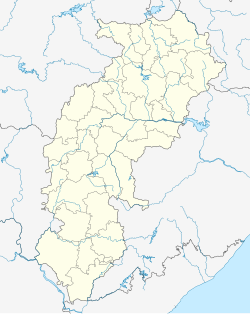Sukma | |
|---|---|
Town | |
| Coordinates: 18°24′0″N81°40′0″E / 18.40000°N 81.66667°E | |
| Country | |
| State | Chhattisgarh |
| District | Sukma district |
| Elevation | 210 m (690 ft) |
| Population | |
• Total | 13,926 |
| Languages | |
| • Official | Hindi, Chhattisgarhi [1] |
| • Other | Odia, Koya, Gondi, Telugu, Savara |
| Time zone | UTC+5:30 (IST) |
| PIN | 4941xx (Sukma) [2] |
| Telephone code | 07864-284001 |
| Vehicle registration | CG |
| Coastline | 0 kilometres (0 mi) |
| Nearest city | Jagdalpur |
| Website | http://sukma.gov.in |
Sukma is a town in Sukma district in Chhattisgarh, India.

